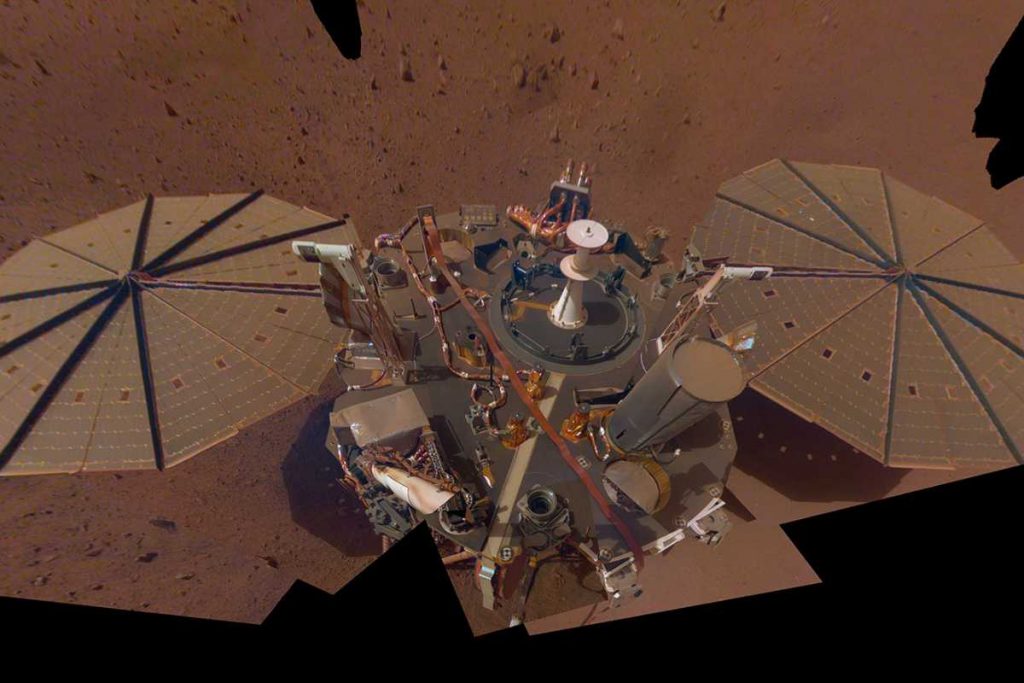The earthquake also lasted for a very long time. About an hour and a half!
Last weekend, Marslander InSight celebrated its 1,000th day on Mars. That party was accompanied by a special reveal. InSight recorded one of the largest Martian earthquakes on record. The earthquake measured a magnitude of 4.2 and — for an hour and a half — also entered the books as the longest earthquake detected by InSight to date.
almost missed
It would have been close if InSight had missed this big earthquake. Because it was originally intended that all of the lander’s scientific instruments – including the seismometer – would be off for a few months. A necessary evil, because Mars revolves around the sun in an elliptical orbit and accelerates toward apogee (the point in the orbit farthest from the sun). In the period around the apogee, less sunlight fell on InSight’s already dusty solar panels. To prevent the lander from suffering from power shortages and not being able to keep important parts – such as the onboard computer and heating – running, all less critical energy consumers are planned to be shut down for a few months sometime in June.
Solve
But then the InSight team came up with a very innovative way to clear some of the dust from the solar panels and thus increase the energy yield. On a windy day, InSight’s robotic arm was allowed to scrape off some sand and then grains of sand fell back next to the solar panels. It was hoped that at least some of the sand – with the help of the wind – would bounce off the solar panels and pick up some dust particles, before the wind would carry them away again. The approach succeeded. And thanks to the slightly clean solar panels, there was also enough energy available at a greater distance from the sun to keep the seismometer running.
Three big orgasms
It paid off. Because the main earthquake observed by the seismometer this weekend is already the third major earthquake that InSight has recorded in a month. At the end of August, two earthquakes of magnitude 4.2 and 4.1 were recorded in one day.
The strongest earthquake recorded by Insight before August 2021 was a magnitude 3.7. This earthquake was detected in 2019. By comparison, a magnitude 4.2 earthquake has five times more energy than a magnitude 3.7 earthquake.
valuable
Earthquakes on Mars are of great value to scientists. Earthquakes produce seismic waves that change as they travel through Mars’ crust, mantle, and core. By studying the waves and the changes they go through, researchers can gain more insight into the formation of Mars.
to analyze
The last major earthquake – which occurred at the end of last week – has yet to be analyzed. But the late August tremors have already been investigated. The research shows that the 4.2-magnitude earthquake occurred at a distance of at least 8,500 kilometers from Insight. This makes it the most distant earthquake that InSight has detected so far. The source of the earthquake is not yet clear. What is certain is that it cannot have originated in the place where most of the earthquakes detected by InSight were generated: Cerberus Fossae, an area about 1,600 kilometers from InSight. An interesting possibility is that the earthquake that InSight recorded in late August originated in Valles Marineris – a massive fault system on Mars. The heart of this valley system is located approximately 9,700 kilometers from InSight.
disagree
What the researchers also noticed is that the two earthquakes detected in late August are very different from each other. For example, the earthquake of magnitude 4.2 was characterized by slow, low-frequency tremors, while the other earthquake, which originated about 925 km from Insight, experienced rapid and high-frequency tremors. The differences are music to the ears of scholars. Recording tremors that originated at different distances from InSight and generate different types of seismic waves is of great value for research into the structure of Mars.
Meanwhile, the distance between Mars and the Sun is shrinking again, and the power InSight can generate using solar panels is increasing nicely. But a new challenge already awaits him: the Mars conjunction. Mars and Earth are on opposite sides of the Sun. Since the sun’s radiation can affect radio signals, there is no temporary connection between Earth and Mars. The last commands will be sent to InSight at the end of this month. Despite the silence of the radio, the seismometer continues to search for tremors.
… has InSight an exercise where it can also conduct research deep into the surface of Mars? With the help of this exercise, NASA wanted to measure the temperature about five meters below the surface of Mars, thus gaining more insight into the amount of heat still coming from the interior of Mars. However, this part of the InSight mission failed. Early this year, NASA threw in the towel; Deep digging turned out to be very difficult.

“Coffee buff. Twitter fanatic. Tv practitioner. Social media advocate. Pop culture ninja.”











More Stories
Which can cause an increase in nitrogen.
The Central State Real Estate Agency has no additional space to accommodate Ukrainians.
The oystercatcher, the “unlucky national bird,” is increasingly breeding on rooftops.